Amazon Handmade vs Etsy: Best Platform for Sellers
I'm looking for...
Not sure whether to sell on Amazon Handmade or Etsy?
This guide cuts through the noise. You’ll get a full breakdown of fees, features, branding, store setup, and dropshipping policies—all updated for 2025.
Whether you’re a new seller or scaling up, find out which platform gives you the edge for selling handmade or POD products online.
Create Your Online Store in just 5 Minutes – For Free
Pick your niche, our AI builds your store, add 10 winning products and we teach you how start selling today. Start picking your niche
Quick Amazon Handmade vs Etsy 2025
🏆 Winner: Etsy More Niche Flexibility
🏆 Winner: Etsy Custom Storefront
🏆 Winner: Etsy Best for POD Sellers
Amazon Handmade: $39.99/month (waived if approved), 15% referral fee (up to 20% on jewelry), no listing fees.
🏆 Winner: Etsy Cost-Effective
🏆 Winner: Etsy Beginner-Friendly
🏆 Winner: Etsy Faster Cash Flow
🏆 Final Winner: Etsy Best for Creators

The best
- More niche audience
- Shop and Seller Dashboard is easy to set up and maintain
- A broad range of categories 140+
- Automatically enrolled in off-site advertising
The worst
- Listing expires after 4 months
- A lot of listing fees
- Constant changes and updates – difficult to track
- If you’re selling a lot, you cannot opt out of advertising
Starting from
- Etsy Plus plan starting at $10; 0.20$ listing fee; 5% transaction fee; 0.25 $ plus a 3% payment processing fee

The best
- Vast audience
- Great Customer Support
- The listing doesn’t need updating.
- Customize shop profile
The worst
- Difficult and a long wait time to be accepted
- Payment is released only after shipping the item
- Only 5 categories for listings
- Difficult to navigate the Seller Dashboard
Starting from
- Significant volume of sales – $39.99 per month; individual sellers – $0.99 per item sold;; 8% to 15% referral fee for each sale
What Is Etsy Handmade?
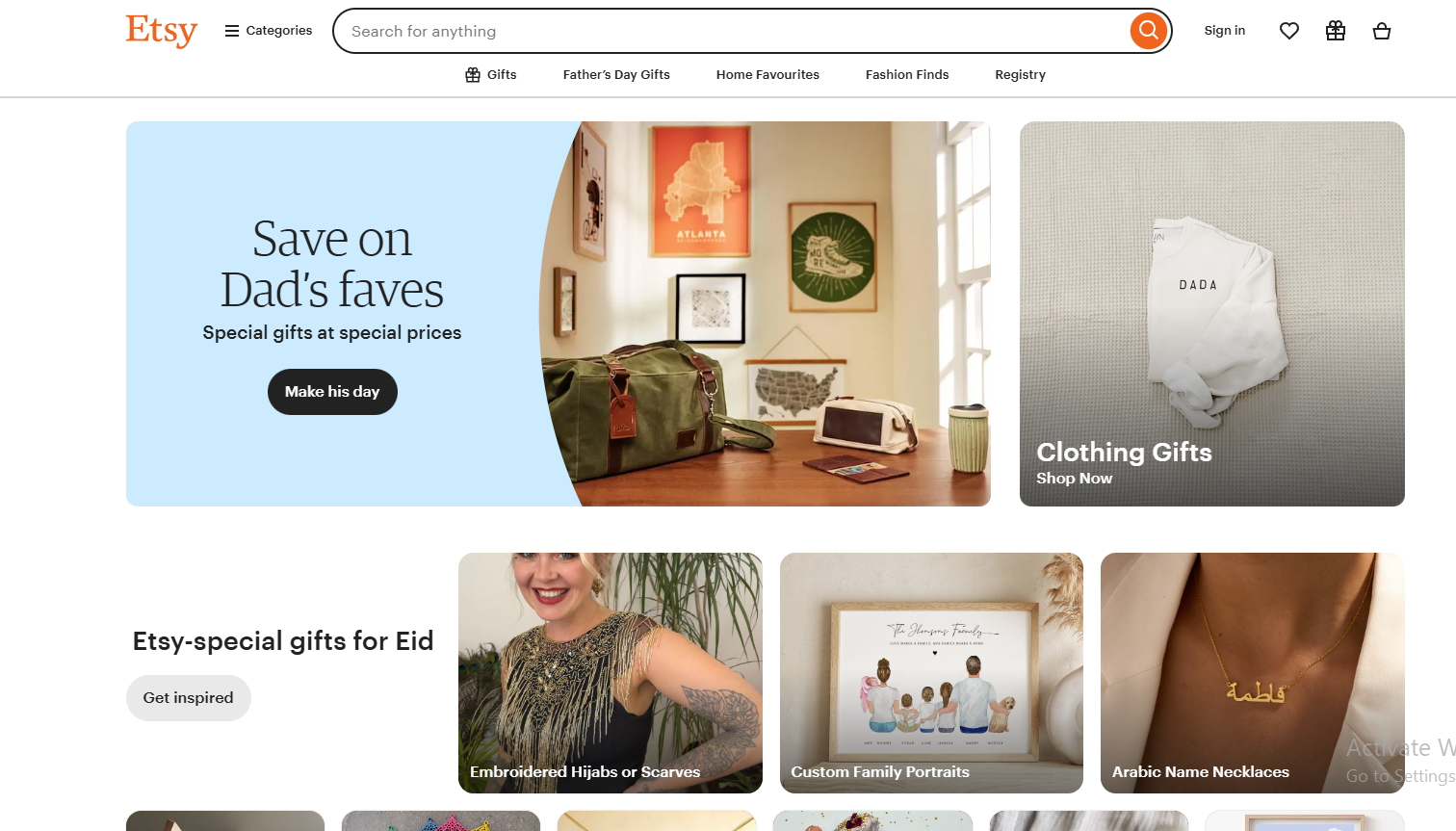
Etsy Handmade is all about selling things you design or create yourself.
That doesn’t mean you have to make everything by hand—what matters is that the product is based on your original idea.
You can even use a production partner like Printful to help you make it, as long as the design is yours and you’re transparent about who helps you.
Etsy wants buyers to feel they’re supporting real creators, so reselling factory-made, mass-produced items is a no-go.
But if you’re customizing, designing, assembling, or altering the product in a meaningful way, you’re good. Just make sure to clearly list your production partner if you’re not doing it all solo.
So whether you make jewelry, art, t-shirts, or digital downloads, if it’s your own creative work.
What Is Amazon Handmade?
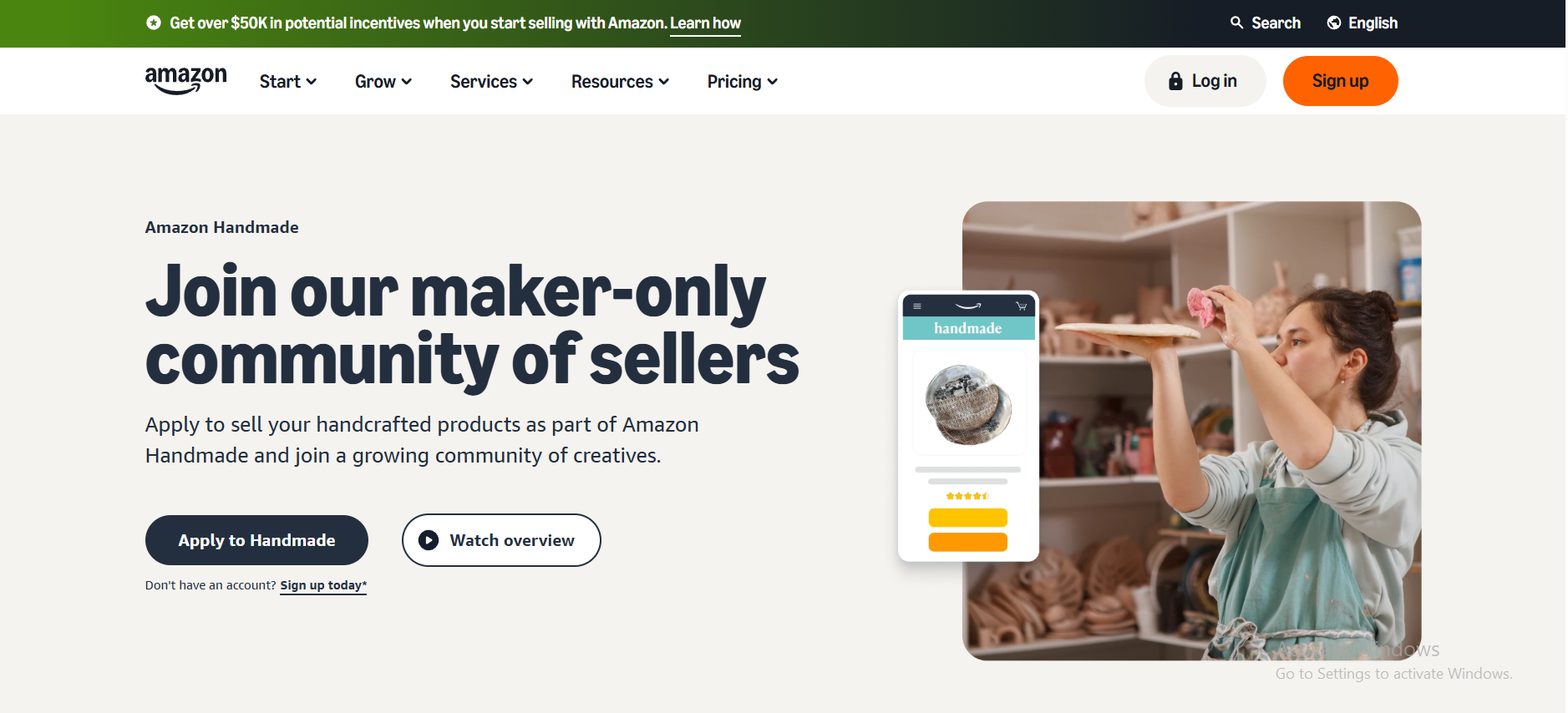
Amazon Handmade is Amazon’s platform for genuine handcrafted products made by artisans—not factories.
It’s designed for makers like you who create original items by hand or with help from a small team. Think of it like Etsy, but inside the Amazon ecosystem.
To sell on Amazon Handmade, you have to apply and get approved, and part of that process includes describing your craft, materials, and production process. Amazon wants to make sure your products are truly handmade—not mass-produced.
You can sell everything from jewelry, home décor, art, and baby items to custom gifts, as long as they’re handmade.
Amazon also gives you access to tools for customization, so if you engrave or personalize your products, it’s fully supported.
In short, Amazon Handmade = handcrafted goods with big-market reach.
Amazon Handmade vs Etsy: Key Features
| Feature | Etsy | Amazon Handmade | 🏆 Winner |
|---|---|---|---|
| Product Categories | 17+ categories with deep subcategories, including digital products and craft supplies. | 14 categories, more general with fewer sub-niche options. | Etsy |
| Store Customization | Custom banners, logos, shop sections, clickable links, and storytelling flexibility. | Limited Maker Profile; no clickable links; basic customization unless trademarked. | Etsy |
| Fulfillment & Dropshipping | Seller/partner fulfillment; POD allowed with original design; custom shipping setup. | No dropshipping; FBA/FBM options; stricter handmade-only enforcement. | Etsy |
| Branded Packaging | Full packaging freedom – custom tape, cards, inserts, branding allowed. | Only branded within Amazon’s terms; no external links or promos. | Etsy |
| Marketing & Advertising | Etsy Ads + Offsite Ads, email campaigns, social sharing, seller tools. | Amazon Ads with PPC only; brand registry needed for advanced tools. | Etsy |
| Pricing & Fees | No monthly cost (Standard), clear CPC, $0.20 listing, 5% transaction, 2.9% processing. | $39.99/month (waived), 15% referral fee, higher Jewelry %s, complex FBA fees. | Etsy |
| Payment Speed | Payouts daily/weekly; funds in 3–5 days; flexible cash flow. | 7-day hold after delivery + 14-day payout cycle; 2–3 week delays. | Etsy |
1. Product Categories
• Artwork
• Baby
• Beauty & Personal Care
• Clothing, Shoes & Handbags
• Home Products
• Jewelry & Watches
• Kitchen & Dining
• Outdoor & Home Care
• Pet Supplies
• Sporting Goods
• Stationery & Party Supplies
• Toys & Games
• Accessories
• Clothing & Shoes
• Home & Living
• Wedding & Party
• Toys & Entertainment
• Art & Collectibles
• Craft Supplies & Tools
• Digital Downloads
• Holiday Shop
• Baby Products
• Electronics & Accessories
• Bags & Purses
• Paper & Party Supplies
• Bath & Beauty
• Pet Supplies
• Books, Films & Music
➡ Amazon Handmade Products
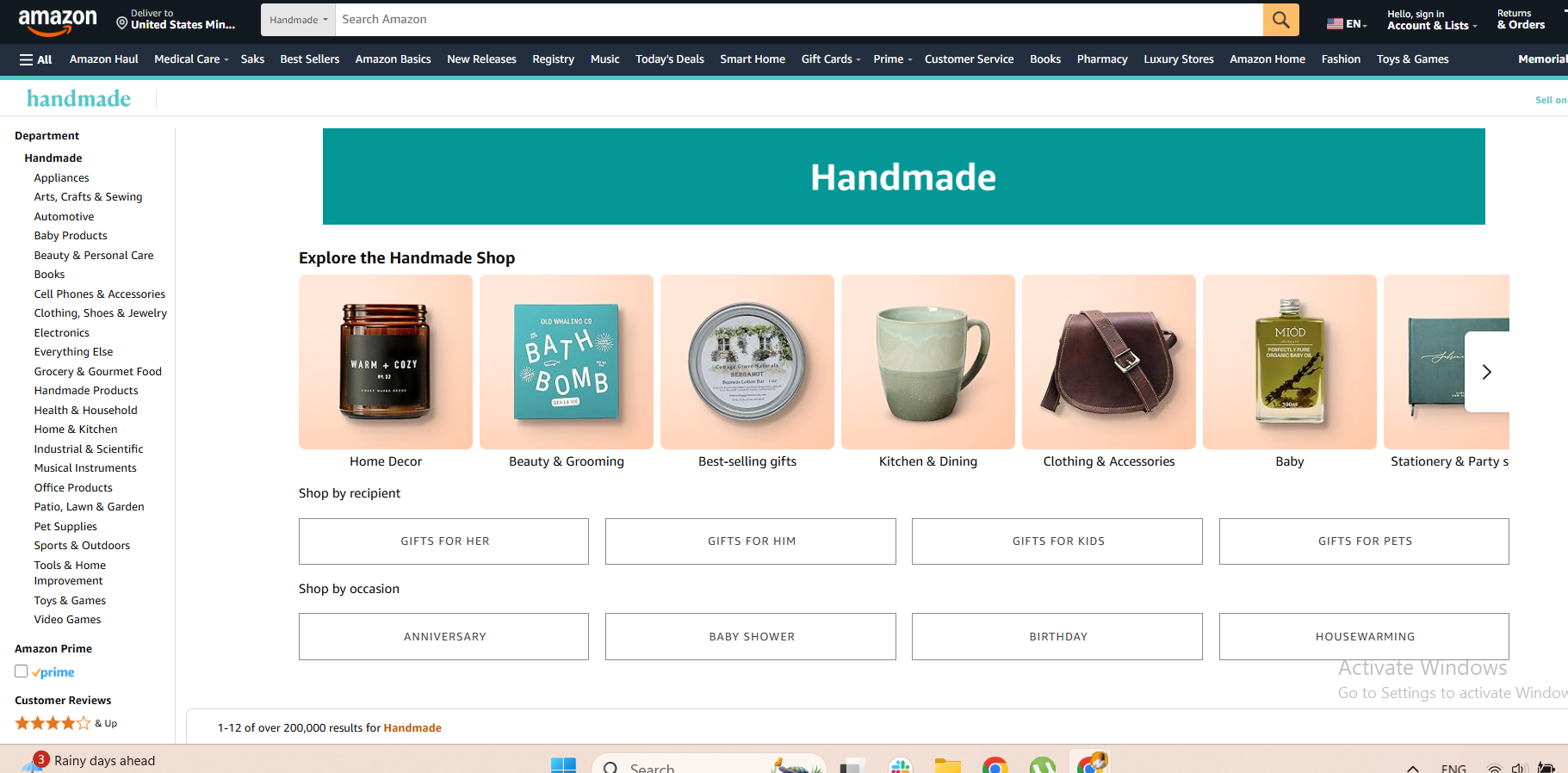
On Amazon Handmade, sellers can offer custom products such as:
- Accessories
- Artwork
- Baby
- Beauty & Personal Care
- Clothing
- Shoes & Handbags
- Home Products
- Outdoor & Home Car
- Jewelry & Watches
- Kitchen & Dining
- Pet Supplies
- Sporting Goods
- Stationery & Party Supplies
- Toys & Games.
💡 Tip: Learn How To Find The Best Dropshipping Niche for Big Profits [Top 10 Niches].
So, they offer handmade items in around 14 categories. Also, they do not fall under a specific “handmade” product category.
➡ Etsy Handmade Products

Similarly, Etsy provides a diverse range of product categories for custom products. And, they offer products from more than 17 categories.
So, you can offer custom items such as home goods, art, crafts, jewelry, and even digital prints. The categories available on Etsy include:
- Jewelry
- Accessories
- Clothing & Shoes
- Home & Living
- Wedding & Party
- Toys & Entertainment
- Art & Collectibles
- Craft Suppliers & Tools
- Digital Downloads
- Holiday Shop
- Baby Products
- Electronics and Accessories
- Bags & Purses
- Paper and Party Supplies
- Bath & Beauty
- Pet Supplies
- Books, Films and Music
Also, all these categories you see, break down into hundreds of sub-categories. So, you have more options on Etsy when it comes to showcasing your handmade products.
👉 Check out the Best Dropshipping Products In Any Niche For Max Profits.
Well, on this one, I will definitely say Etsy is the winner.
2. Store Customization
• Include links to your website, email list, or socials in the “About” section
• Showcase your story and brand identity
• Design a unique logo and use niche-aligned visuals
• Group listings into sections like bracelets, pendants, or earrings
• Add compelling descriptions and high-quality images
• Reflect brand personality with full creative freedom
• Limited customization within Amazon’s default layout
• No clickable links in your shop profile
• Product previews available on custom listings
• Storefront available only if you own a trademark and use Brand Registry
• Info section allowed, but no branding layout flexibility
➡ Etsy Store Customization
Etsy provides clean and attractive designs to help you organize your store.
When it comes to customization, On Etsy, you have the ability to upload a custom shop banner, include links to their website, email list opt-in, and social links in your “About” section.
Here you can share who you are, why you started, and what sets your products apart from others. It’s also a great place to add links to your website, social platforms, or email list to keep customers connected.
Also, you can design a unique shop banner and logo that reflect your brand’s personality. For instance, if your niche revolves around sustainable items, lean into earthy tones and organic design elements to reinforce that message.
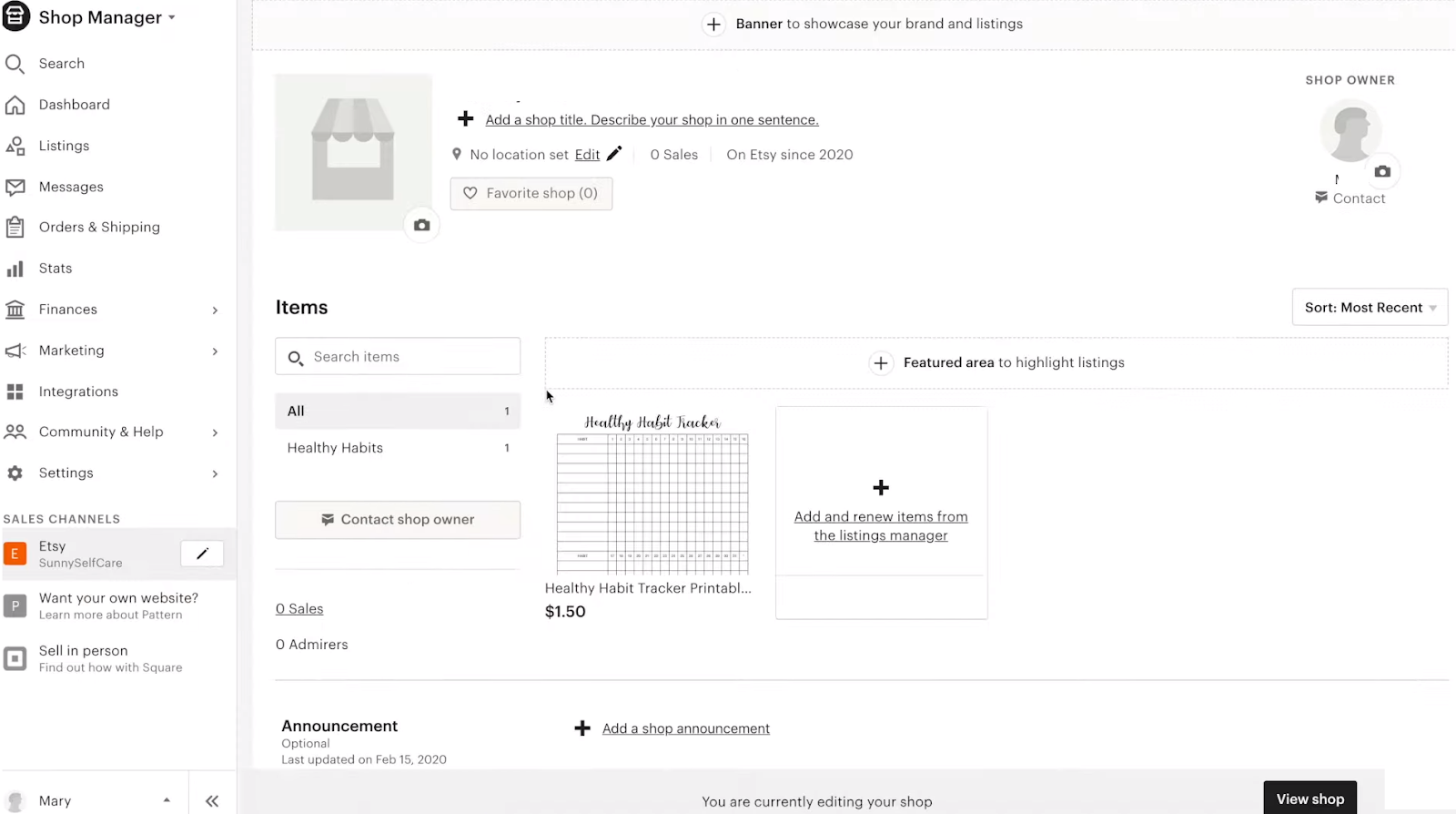
Hence, you can group your items into themed sections for better navigation. Selling handmade jewelry? Set up distinct categories like bracelets, earrings, or pendants to help shoppers find what they need quickly.
You can write compelling product descriptions and upload crisp, clear photos, etc.
➡ Amazon Handmade Store Customization
However, on Amazon Handmade, the level of shop customization is more limited.
After approval, you get a Maker Profile page where you can add a banner image, profile photo, and a written story about your craft (like an “About the Maker” section).
Also, Amazon has improved its customization features. So, your personalized products can show preview windows on detail pages.
Customers can click through to see all your listings and read about you, but the overall look is still an Amazon page.
There’s no freehand layout beyond your banner and text. (Amazon does allow brand storefronts via the Brand Registry, but that’s for trademarked brands – Handmade sellers can register a brand if they have a trademark, then use Store Builder, but many don’t.)
While you can still provide information in your “About” section, you do not have the option to include clickable links.
So, you cannot directly link to your website, social media platforms, or other online presence.
Clearly, Etsy offers sellers a clear advantage in terms of shop customization.
👉 Learn How To Open and Manage Multiple Shopify Stores (Tips + Apps).
3. Fulfillment & Dropshipping Policies
| Feature | Etsy | Amazon Handmade |
|---|---|---|
| Fulfillment | Seller or production partner must fulfill orders. No retail arbitrage or reselling generic items. | Only handcrafted items made by you or your team. Registered partners allowed if you control design and quality. |
| Dropshipping | Not allowed. Print-on-demand is allowed if you manage the process and disclose the partner. | Generally not allowed. Dropshipping violates Handmade rules unless it’s authentic artisan work. |
| Shipping | Set your own rates via shipping profiles. Use discounted postage labels via Shop Manager. Seller handles returns. | Choose FBM (you ship) or FBA (Amazon ships). FBA includes Prime badge but adds fees. |
| Packaging & Branding | Custom packaging allowed. No external links or coupons inside the box. | “Ships in Product Packaging” program lets you use branded boxes with logos and inserts. |
| Customer Service | You manage all returns and support. | FBM: you handle it. FBA: Amazon handles returns and support. |
Etsy
Etsy is not a traditional dropshipping platform. All orders must be fulfilled by the seller or a registered production partner.
Etsy strictly forbids reselling or retail arbitrage—meaning you can’t just buy cheap products elsewhere and list them on Etsy.
The only exception is if you’re offering craft supplies meant to be used by others for handmade projects, and even then, your store should focus on creative materials, not generic goods.
Print-on-demand (POD) is allowed only if the design is originally yours and you manage the entire process.
These POD or manufacturing services must be listed as production partners in your shop settings, and your customers should feel they’re buying your original design, not a mass-produced item.
Furthermore, it gives you the freedom to set your own shipping policies using shipping profiles. You can purchase discounted postage labels through Shop Manager, and Etsy integrates much of the shipping workflow. However, you’re responsible for all returns and customer service, not Etsy.
However, Etsy does partner with postal services in the States and international ones like FedEx to help you streamline and ship out your order fulfillment.
Etsy also provides a 30% discount on postage rates, if you are using the platform to create labels directly.
💡 Important: Etsy allows branded packaging, but no promotional inserts—that means no coupons or links to external websites inside your packages.
Amazon Handmade
Amazon Handmade also maintains a strict handmade-only policy. Products must be genuinely crafted by you or your immediate team.
While you can use production partners, you must still retain intellectual ownership and quality control.
Any form of mass production or simple resale goes against Amazon’s guidelines and may result in removal.
As a Handmade seller, you have two fulfillment options:
- Fulfilled by Merchant (FBM): You ship products directly or via a 3PL (third-party logistics provider). This gives you full control over packaging, shipping times, and customer communication—but it also means more work.
- Fulfillment by Amazon (FBA): You send your items to Amazon’s warehouses, and Amazon handles the packing, shipping, and customer service. This enables Prime eligibility, which can increase your sales. However, FBA charges storage and fulfillment fees.
The difference between the two is that Fulfillment by Amazon does the shipping and fulfillment for you, while Fulfillment by Merchant means that you do the whole shipping, and fulfillment by yourself.
To retain your branding while using FBA, Amazon offers the “Ships in Product Packaging” program, allowing you to send your products in custom-branded boxes, instead of Amazon’s standard packaging.
💡 Reminder: Although Amazon does allow dropshipping under certain conditions (you must be the seller of record), this is not compatible with Handmade, as all products must be authentically made by you.
Labeling a factory’s goods as your own would violate Handmade’s rules.
👉 Learn about Dropshipping Returns: How To Set Up Your Returns & Refunds? [Full Guide].
👉 Read about What Does Shipped Mean In Dropshipping?
4. Branded Packaging
• Add custom labels, logos, thank-you cards, and discount codes
• Flyers allowed as long as they don’t promote other platforms
• Etsy label printing available, but not required
• Build brand identity using branded tape, wrapping, and cards
• Avoid Etsy logo or “Handmade on Etsy” stock phrases
• No external links in packaging (no Etsy, Instagram, etc.)
• FBM: More creative flexibility, but must meet Amazon’s policies
• FBA: Must follow strict Amazon packaging rules (polybags, barcodes)
• “Ships in Product Packaging” allows branding inside boxes
• Must remove old seller info or labels if reselling inventory
➡ Etsy Branding
On Etsy, you have the freedom to include personalized touches like business cards with your packaging.
It encourages branded packaging: you can put your logo and return address on labels, include flyers or thank-you notes (as long as they don’t advertise other marketplaces).
Etsy sells custom label printing, but you can use any printer or service.
There are guides like “Branded Packaging Basics” on Etsy, but the upshot is: make it your brand (labels, business cards, custom tissue paper, etc.).
Just don’t use the Etsy logo or stock phrases like “Handmade on Etsy.”
So, you can add:
- Customized stickers or labels with your shop logo or name to add a personal touch to your packages.
- Thank you cards or notes expressing gratitude for the customer’s purchase.
- Branded tissue paper or wrapping paper with your shop logo or design to enhance the presentation of the product.
- Customized packaging tape with your shop name or logo to add a professional and branded look to your packages.
- Customized packaging inserts, such as discount codes, promotional materials, or product samples, etc.
By including these extra promotional materials, you can build a stronger connection with your customers beyond just the transaction.
👉 Read about Branded Dropshipping: Best Tactics For Building A Strong Brand?
➡ Amazon Branding
In contrast, Amazon offers branded packaging but strictly prohibits any links to external websites in packaging.
This means that you are limited to promoting your Amazon store only. Hence, you cannot include any marketing materials that reference other websites or sales channels. (E.g., you can’t put an Etsy shop link on your packing slip.)
If using FBA, your product must meet Amazon packaging standards (resistant polybags, suffixed weight labels, etc. per FBA requirements). But if you’re FBM, you can package creatively – just remove Amazon pack slips if shipping yourself. (And always remove any previous seller’s labels if you sourced from a manufacturer.)
While this may seem restrictive, it is important to note that Amazon has its own massive customer base, and promoting your brand within its platform can still be beneficial.
Overall, while Etsy allows for more freedom in including business cards and extra promotional materials with packaging, Amazon’s prohibition on external links doesn’t diminish the value of branded packaging.
👉 Check out Private Label Dropshipping: 20 Suppliers To Start With.
5. Marketing & Advertising Tools
• Sponsored Brands/Videos: Only with Brand Registry
• High competition: Requires keyword optimization and budget control
• Featured in Amazon Gift Guides and seasonal promotions
• Amazon Custom Integration: Let buyers preview personalization live
• Prime-eligible listings: Boost visibility via FBA
• No separate ad dashboard for Handmade – uses core Amazon Ads
• Offsite Ads: Etsy advertises on Google, Facebook, and more
• 15% ad fee (or 12% if sales exceed $10K) – capped at $100/order
• Opt-out available for smaller sellers
• Social media integrations: Share listings directly
• Email campaigns: Reach customers with promotions and updates
• New 2025 tools: Photo filters, listing quality tips, and faster dashboard
👉 Check out the 14 Best Marketing Practices For Your Online Store in 2025 + Real Examples.
➡ Amazon Handmade Marketing & Advertising
As a Professional Seller on Amazon Handmade, you gain full access to Amazon Advertising tools, including:
- Sponsored Products Ads: These are PPC (pay-per-click) campaigns targeted by keywords or specific ASINs.
- Sponsored Brands and Videos: Available only if your brand is officially registered with Amazon.
While there’s no separate ad program just for Handmade, your listings are promoted through Amazon’s standard advertising system, giving you access to Amazon’s vast customer base.
However, competition is high, and effective campaigns require strong targeting and budget management.
Additionally, Amazon promotes Handmade listings through broader marketing efforts like seasonal gift guides and homepage features, especially during holidays. This visibility can lead to more traffic without extra ad spend.
Another major benefit is Prime-eligible fulfillment through Amazon’s global network, which often leads to higher organic sales, especially if your products align with current shopper trends.
Amazon Custom Integration
One standout feature for Handmade sellers is Amazon Custom, which now offers enhanced customization tools (launched in 2023). These allow customers to:
- Add text or upload images directly on your product page.
- See live previews of their customizations before purchase.
This feature is especially powerful for sellers offering engraved items, custom mugs, or personalized gifts, and can significantly boost conversion rates if you update your older listings to include these options.
While Etsy also supports personalization, Amazon’s new customization interface provides a smoother, more interactive experience for buyers.
➡ Etsy Handmade Marketing & Advertising
Etsy’s built-in marketing system is designed around its search-driven and social commerce ecosystem. Here’s how sellers can promote their listings and grow visibility:
Etsy Ads (Onsite Advertising)
You can run cost-per-click (CPC) Etsy Ads to promote your products directly on the platform.
These ads appear at the top of Etsy search results and category pages, and you can control how much you spend by setting a daily budget.
Ads are easy to manage and can help new listings get initial traction.
Offsite Ads (External Advertising)
Etsy also promotes your listings outside the platform through Offsite Ads — including placements on Google, Facebook, Instagram, and other partner sites.
- Fee Structure: If a customer makes a purchase after clicking one of these ads, Etsy charges a 15% fee (reduced to 12% after you reach $10,000 in sales).
- Opt-Out Eligibility: Offsite Ads are mandatory for most sellers, but smaller shops can opt out once.
- Fee Cap: You’ll never be charged more than $100 per order, and you only pay the fee if the sale is attributed to the ad.
Other Etsy Promotional Tools
Etsy also gives you tools to boost engagement and conversions, including:
- Coupon codes and store-wide sales events.
- Social media integrations to share listings directly to platforms like Instagram or Pinterest.
- Email campaigns for engaging followers and promoting new products.
New Seller Tools in 2025
Etsy has introduced several new features to streamline selling:
- Photo filters for product listings to improve visual appeal.
- “Listing Quality” suggestions in the Shop Manager to help optimize performance.
- A faster Shop Manager interface with improved layout and quick access to seller support.
These features come at no additional cost, but they make listing management more efficient and user-friendly.
🚀 Tip: On Etsy, try to build an audience by linking your shop on social media and encouraging followers – Etsy’s built-in stats show “who favorited” and “who viewed” your items.
On Amazon, focus on Amazon SEO (title/keyword optimization) and consider running small PPC campaigns to jump-start visibility, especially since Handmade has no internal “curated collections” beyond search.
Signing Up & Getting Approved
| Step | Etsy | Amazon Handmade |
|---|---|---|
| Account Type | Free Etsy Seller account | Amazon Professional account ($39.99/month initially) |
| Application Process | Instant onboarding with ID + selfie verification | Manual approval with detailed Handmade application and product/process description |
| Fees Charged | $0.20 listing fee + one-time non-refundable setup fee (charged next month) | $39.99 upfront, refunded monthly if Handmade approved (saves ~$480/year) |
| Bank & Card Setup | Bank account via Plaid, credit card for billing | Credit card and bank account added during account setup |
| Product Listings | No UPC/EAN required; handmade tags allowed | UPC/EAN or GTIN exemption required; categorized with Amazon standards |
| Verification Needed | ID and selfie verification, 2FA required | Handmade application with workspace photos and maker profile |
| Processing Time | Usually same day if ID verified | Several days to over a week depending on vetting |
Etsy makes it easy to get started, but it now includes a mandatory identity check. New sellers must upload a government-issued ID and a selfie for verification. After that, you’ll choose your shop name, list your first products, and set up your payment information.
If you’re in the U.S., Etsy uses Plaid to securely connect your bank account. You’ll also need to add a debit or credit card for paying seller fees. As of 2025, customers in Germany, Austria, and the Netherlands must have a payment method on file when they sign up.
At the end of the onboarding process, Etsy charges a one-time non-refundable shop setup fee, along with the standard $0.20 listing fee per product. Two-factor authentication is now required for all seller accounts, and once everything is completed, you can officially open your Etsy shop.
On the other hand, Amazon Handmade requires a bit more upfront commitment. To apply, you must first create an Amazon Professional seller account, which costs $39.99 per month.
This fee is charged right away—but here’s the benefit: if your Handmade application is approved, that monthly fee is waived indefinitely, saving you around $480 annually.
Once you’ve registered, you’ll go to the “Programs” section and apply to Handmade by describing your craft, your process, and your product types. Amazon reviews every application individually, and approval can take several days.
After you’re approved, you’ll be asked to classify your products using specific Handmade attributes like “handcrafted” or “upcycled.” You’ll also need to either provide a UPC/EAN for each listing or request a GTIN exemption, which is now required due to Amazon’s updated listing policies.
Finally, Amazon will prompt you to create a Maker Profile where you introduce yourself and your process to buyers. This page is a chance to build trust and show authenticity.
How Do I Sign Up On Etsy As A Seller?
Unlike Amazon Handmade, signing up on Etsy is way easier. So, here are the steps you need to take.
You visit Etsy.com/sell and click on the Get Started button.
Given the area and your target audience, you select the language, currency, and country where you want your shop to be located. When you fill out all of this information, click Save and Continue.
Then you choose a shop name and again click Save and Continue.
And, there you go! You are signed up for Etsy Handmade. Next, you need to set up your store, listings, payment method, etc.
Please bear in mind that you have to do the first step via a desktop browser. To mention, you can manage it through the phone app when your shop is open.
👉 Also, check out my guide on Shopify Vs Etsy: The Ultimate Reviews For Online Sellers.
How Do I Sign up On Amazon Handmade As A Seller?
Amazon Handmade is way more difficult to sign up for. Not only that, but you also need to get approval from Amazon first. Now, let’s see what you need to do.
First, go to the Amazon seller page, and click on ” Sign up”.
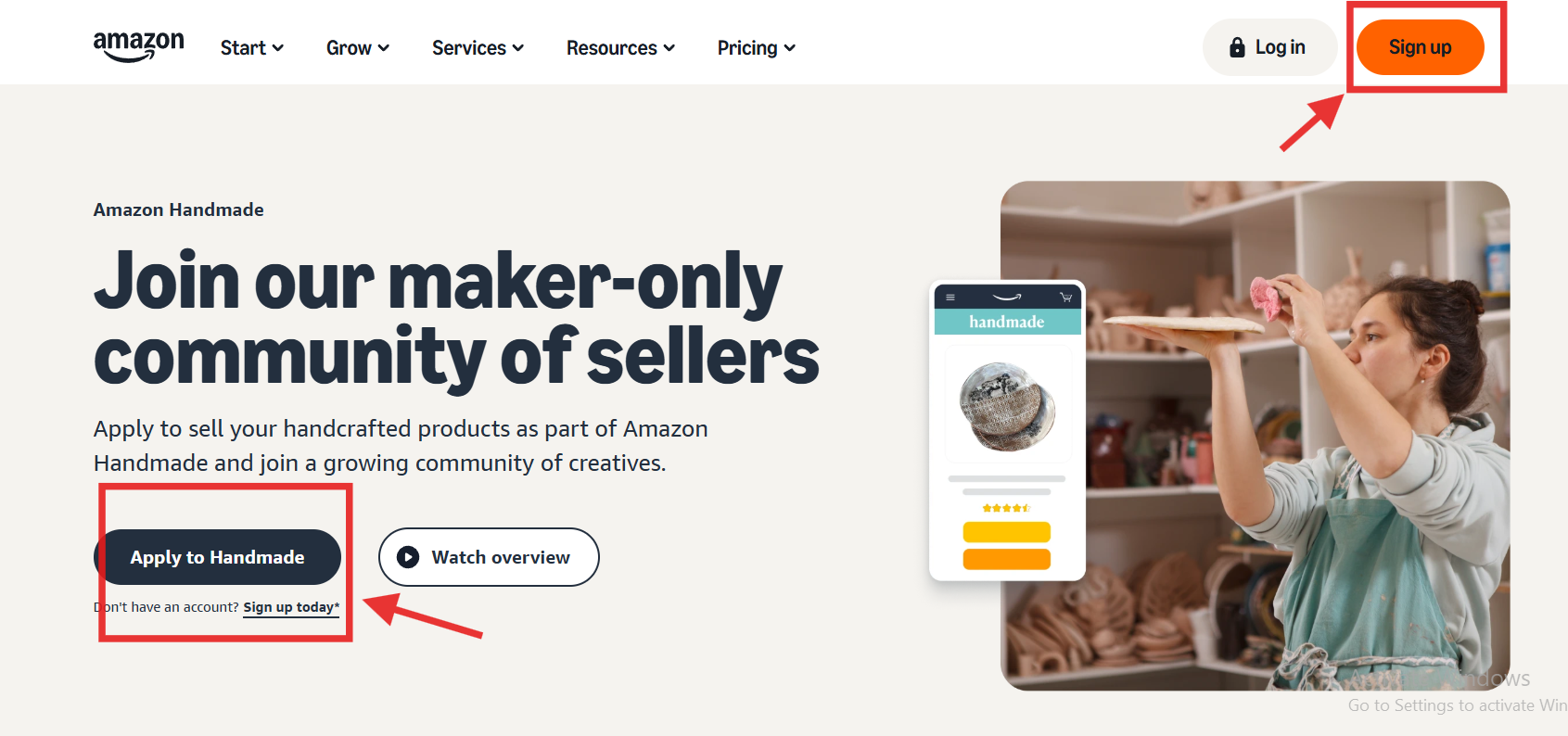
Next, you will enter your email and click on ” Create Amazon account”. Once you do that, the application process starts by adding your personal information, like, first name, last name, proof of identity, business address, etc.
Also, you have to add your billing information, upload the documents like your passport, etc.
Next, Amazon requires answers to some store information, and once you are done, you will get your verification.
However, that’s not all. Now, you might be wondering, “So, how do I get approval to sell on Amazon Handmade?”
There are several things to keep in mind here, such as:
- You must have a pre-approved selling Amazon account that has a professional selling plan.
- You must have a license to sell – you can’t have a restriction on selling.
- Your company cannot be bigger than 20 workers.
- You can only have one seller account – Amazon is really strict about this. They want to make sure you are who you say you are. So, be careful about this.
Also, in order to sell handmade, you need a professional Amazon account. The approval process typically takes a few weeks. Amazon evaluates the uniqueness and authenticity of your handmade items.
First, you need to enter and add your name, email, your business info, etc.
Next, they also require photos from your work. So, you can make a few screenshots from your products, or your workshop.
Also, they require you to explain what you do, your process of work, or how you produce your products.
Now, let’s look at their features.
How To Create Your Storefront On Amazon Handmade (Step-by-Step)?
Selling your handmade products on Amazon can open up new opportunities and help you reach a wider audience. So, here is my step-by-step guide on how to sell handmade on Amazon:
As I already explained above, to start selling on Amazon, you need a Professional Seller account. So, you need to sign up on Amazon Seller Central and provide the necessary business information. Once you have a Professional Seller account, apply for the Handmade category. Amazon will review your application to ensure your products meet their criteria.
Let’s see what’s next.
After approval, create a free shop on Amazon Handmade. Customize your storefront, shop policies, and return/exchange policies.
So, to customize your storefront, from the menu go to Stores> Manage Store. Hence, the customization starts once you start adding your brand information, like brand display name, and brand logo.
Furthermore, you can create your storefront layout, add meta descriptions, define products display, add tiles, sections, etc.
Also, you need to upload high-quality images and write detailed descriptions for your handmade products. So, go to Inventory> Add a product.
Next, you need to organize your products into relevant categories to make it easier for customers to find them. So, choose the category and sub-category that best describes your products.
After that, you can write a product title, product description, add size charts, product variations, images, keywords, and many other details.
So, to add photos, just navigate to the “Images” section, and here you can upload multiple product photos. However, make sure they are high-quality size images that can really showcase your product.
Next, you can set your SKU, product pricing, quantity, shipping template, production time, shipping method, etc.
Once you are done, click on the “Save and Finish” button.
How To Create A Storefront On Etsy (Step-By-Step)?
Selling handmade products on Etsy is a popular option for artisans, crafters, and makers looking to showcase their creations to a wider audience. Here is a step-by-step guide to get started.
So, you can start adding your handmade items to your shop from the ” Stock your store” section. Include listing details, like clear photos, detailed descriptions, and appropriate categories to help potential customers find your products easily.
👉 Want to automate your product-importing process? Check out my Megamo Review: Automate Product Import To Your Store.
Next, choose the payment methods you wish to offer to customers. Etsy offers various options, including credit/debit cards, PayPal, and Etsy Gift Cards.
Also, you need to set you your billing information, like credit/debit card, billing address, etc.
Furthermore, personalize your shop’s appearance by customizing the header, logo, and shop policies. This enhances your brand identity and gives customers a better view of your business.
By following these steps, you can easily set up your shop and start selling your handmade products on Etsy.
Amazon Handmade vs. Etsy: Pricing Structure
• Plus Plan: $10/month – Includes 15 listing credits + $5 ad credit
• Pattern Plan: $15/month – Build your own branded site
• Listing Fee: $0.20 per item
• Transaction Fee: 5% on total order amount
• Payment Processing: ~2.9% + $0.30
• Currency Conversion: 2.5% if currencies differ
• Offsite Ads: 15% fee, or 12% if over $10K in sales
• In-person via Square: 2.6% + $0.10 + 5% shipping fee
• Etsy Ads: Pay-per-click (CPC) cost varies
• Referral Fee: 15% standard – Jewelry/Watches: 20% on first $250, then 5%
• Listing Fee: None – unlimited listings
• Fulfillment: Optional FBA fees (based on size/weight); FBM is DIY
• No new fee types promised for 2025
• Inbound placement fees: Average $0.58/unit for large items
• Other Perks: Custom storefronts, Prime shipping access
Etsy Pricing Plans
Etsy gives sellers three plan options to choose from, each designed for different needs:
Standard Plan – Free of Charge
The Standard Plan costs nothing and grants access to Etsy’s basic seller tools. You’ll be able to manage orders, communicate with customers, and receive alerts, like when a listing is close to expiring.
You also get analytics showing store visits, revenue, and traffic trends. It’s a great starting point, though it comes with limited features compared to paid plans.
Plus Plan – $10/month
For sellers ready to upgrade, the Plus Plan includes everything in the Standard tier and then some.
You receive 15 free listing credits each month (a $3 value) and a $5 Etsy Ads credit.
It also comes with perks like discounts on branded packaging and business supplies. You can further personalize your shop’s layout with banners, feature specific items, and send customers restock alerts via email.
Pattern Plan – $15/month
The Pattern Plan is ideal for creating a stand-alone website with its own domain, while still managing everything through your Etsy seller dashboard.
Although your listings can appear on Etsy, this plan is tailored for sellers who want an online presence outside the marketplace itself.
Other Etsy Selling Fees to Know:
- Listing Fee: Each item posted costs $0.20. This fee is charged once per listing, even for multiple quantities.
- Transaction Fee: Etsy takes 5% of the total sale price, including personalization, gift wrap, and shipping costs.
- Payment Processing Fee: These vary by country and processor, but generally sit around 2.9% + $0.30 per sale.
- In-Person Sales via Square: Charges are 2.6% + $0.10 per transaction, plus a 5% fee on any shipping costs.
- Etsy Pattern Fee: This applies only if you’re using the Pattern website builder—$15 per month.
- Advertising Fees: For on-site Etsy ads, you pay per click. For off-site ads (e.g., Google), Etsy takes 12% to 15% of each sale.
- Currency Conversion Fee: If your item is listed in a currency different from the buyer’s payment currency, there’s a 2.5% conversion fee.
Amazon Handmade Pricing Plans
➡ On the other hand, Amazon provides professional selling plans for sellers who expect a significant volume of sales, priced at $39.99 per month, while individual sellers are charged $0.99 per item sold.
In contrast, Amazon implements a referral model for fee charging.
| Fee Type | Details |
|---|---|
| Professional Selling Plan | $39.99/month (waived for Handmade sellers after the first month) |
| Referral Fee | 15% on total sales price; Jewelry & Watches: 20% on first $250, then 5% |
| Listing Fee | None — unlimited free listings |
| Fulfillment Fees | Optional FBA fees based on size/weight; FBM handled by seller |
| Other Benefits | Custom storefronts, Prime eligibility with FBA, global customer reach |
Sellers are required to pay referral fees for every product sold, and these fees differ based on the category of the product.
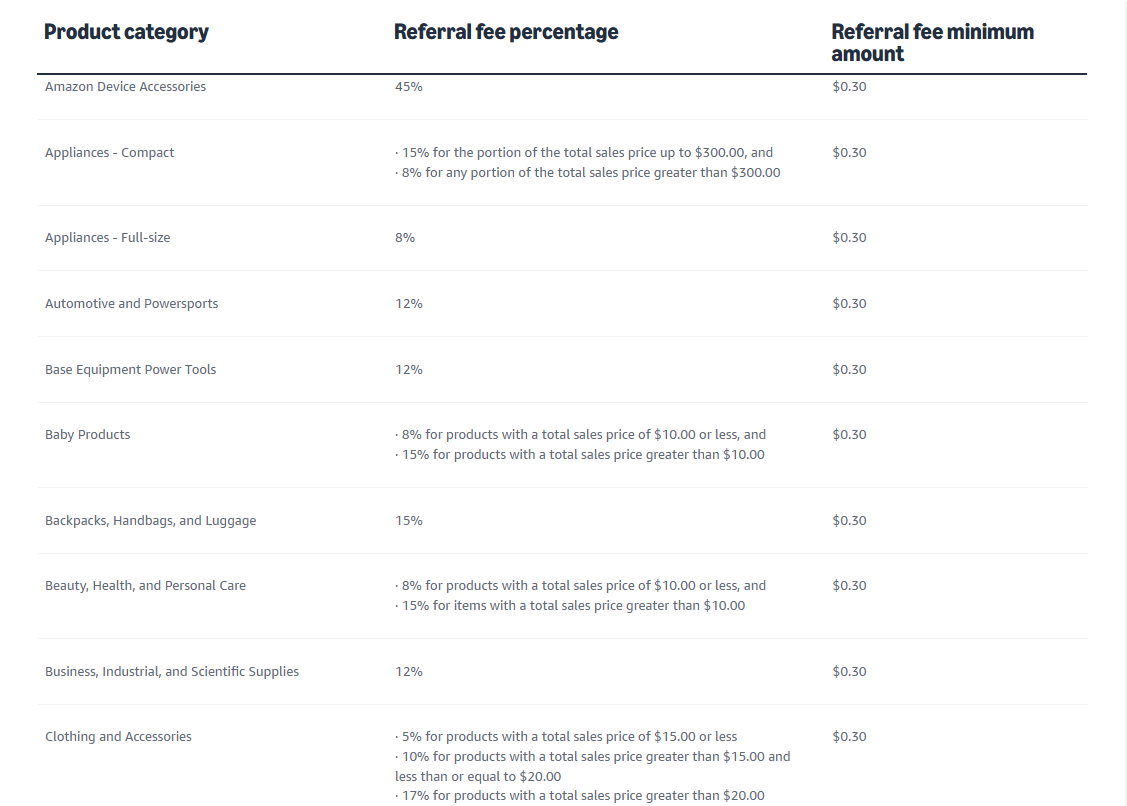
One subtle benefit: approved Handmade sellers now effectively never pay a monthly fee after the first month. Also, Amazon will not increase US referral and FBA fees and will not introduce any new fee types.
So, the inbound placement service fees for large, bulky-size products average $0.58 per unit for minimal shipment splits.
As you can see, the Amazon Handmade monthly subscription might be higher for large volumes, and it has additional fees.
Amazon Handmade vs Etsy: Which Platform Provides Faster Payments?
| Feature | Etsy | Amazon Handmade |
|---|---|---|
| Payment System | Etsy Payments | Amazon Standard Disbursement |
| Payout Frequency | Flexible – daily, weekly, biweekly, or monthly | Fixed – every 14 days |
| Transfer Timeline | 3–5 business days after payout initiation | 3–5 business days after payout release |
| Hold Period | No set hold, but reserves may apply to new accounts or large sales | ~7 days after delivery per order before disbursement begins |
| Cash Flow Speed | Faster access with flexible settings | Slower – typically 2–3 weeks after each sale |
| Risks of Delay | Reserves for refunds or high-risk activity | Delays due to poor seller performance or A-to-z claims |
| New Seller Policies | Possible temporary reserves | Initial holds until seller reliability is proven |
Etsy
- System: Payments are managed through Etsy Payments.
- Payout Frequency: You can choose your disbursement schedule — daily, weekly, biweekly, or monthly — directly in your Shop Settings.
- Transfer Time: Once Etsy initiates the payout (via ACH or Payoneer), funds typically arrive within 3–5 business days.
- Minimum Threshold: Payments are only sent if your balance meets the payout minimum.
- Cash Flow Flexibility: Since frequency is adjustable, Etsy offers more control over cash flow.
- Reserves: Etsy may hold a reserve for new sellers, shops with high-risk transactions, or unusually large orders to cover possible refunds or chargebacks.
🪡 Amazon Handmade
- System: Amazon uses its standard disbursement schedule across Handmade and regular accounts.
- Payout Frequency: Funds from each order are held until ~7 days after delivery, to account for return windows.
- Payout Cycle: After the hold period, payouts are issued every 14 days (biweekly).
- Transfer Time: Once issued, payouts take 3–5 business days to reach your bank via ACH.
- Cash Flow Delay: Realistically, you may wait 2–3 weeks after each sale to access your earnings.
- Account Holds: Amazon may delay payouts for performance-related issues like late shipments or A-to-z claims.
- New Seller Holds: New Handmade sellers may experience additional payment holds until they establish reliability.
👉Check out the Best AliExpress Alternatives in 2025.
Pros & Cons Etsy vs Amazon Handmade
Amazon Handmade and Etsy seem to have a lot of similarities and a lot of differences.
Thus, each platform offers a myriad of possibilities. Let’s have a look first at the Amazon Handmade ones, followed by Etsy.
👉 Check out Dropshipping Berluti: How To Dropship Handmade Luxury?
🔸 Amazon Handmade Pros & Cons
🔸 Etsy Handmade Pros & Cons
In my opinion, if you choose to go with Amazon Handmade, you get a base of around 300 million potential customers interested in everything.
In case you choose Etsy, you will get a base of about 35 million potential customers who are specifically interested in handmade goods and vintage items. Also, above $10K sales, Offsite Ads 15% is effectively a 15% fee on many orders (unless you opt out, but that’s only once).
On the other hand, Amazon doesn’t need you to update the listing, while on Etsy, you have to update it after 4 months. However, their handmade listings compete with millions of Amazon products; good SEO and ads may be needed to be found.
Now, it’s time to have a look at the possibilities of Amazon Handmade vs Etsy shipping and fulfillment options.
How Fulfillment and Dropshipping Work on Amazon Handmade vs Etsy
Etsy
Etsy requires that all orders be fulfilled by the seller or a disclosed production partner. The platform strictly prohibits traditional dropshipping and reselling of mass-produced goods. The only partial exception is for crafting supplies, but even those must focus on creative or handmade elements, not generic wholesale items.
If you’re selling gift baskets, for instance, Etsy expects that they’re curated and assembled by you, not sourced as pre-made products. While print-on-demand is allowed, it must involve your own original designs, and you must clearly disclose any production partners used.
Etsy offers tools like:
- Shipping profiles, where you can set your own shipping rates and timelines.
- Discounted postage labels via Shop Manager.
- Manual handling of customer service and returns by the seller.
In essence, Etsy supports artisan-style production, not retail arbitrage or passive fulfillment.
Amazon Handmade
Amazon also does not allow classic dropshipping. You must either fulfill orders yourself or use Fulfillment by Amazon (FBA) if eligible. With FBA, Amazon handles shipping, customer service, and returns — which can significantly boost trust and Prime-eligible visibility.
Unlike Etsy, Amazon Handmade allows you to benefit from:
- Built-in global fulfillment infrastructure.
- Automatic inclusion in Prime shipping when using FBA.
- Streamlined customer service support managed by Amazon itself.
If you’re listing customizable items, Amazon Custom (integrated into Handmade) allows personalized fulfillment, but you still need to manage inventory or send stock to FBA.
Which is Better for Dropshipped Handmade?
If your model truly relies on outsourcing production or drop-shipping ready-made goods, neither platform is a perfect fit – both require your creative input and authenticity.
However, if by “dropshipping” you mean using a print-on-demand or production partner to create your original designs on demand, here’s how they compare:
Etsy
Etsy allows print-on-demand and partners, if it’s based on your design. Many artists use POD for custom art (mugs, shirts).
You just have to clearly explain in listings that it’s “custom-made” and use your own design templates.
Sellers often mention “made when ordered with our partner factory.” Etsy’s advantage is its strong niche audience and easier store branding. But you won’t succeed by simply reselling generic items.
Amazon Handmade
Amazon Handmade also allows production partners under strict terms.
In fact, Amazon just released more tools for customized products (so if you do engraving or printing on demand, it’s well-supported).
The upside is access to big-market demand (e.g. personalized gifts searchers). The downside is that Amazon customers rarely search “handmade,” so SEO/ads are crucial. And your margins must account for the 15% referral.
Also, if your partner handles shipping, you still must ensure speed – Amazon doesn’t forgive late shipping.
What Real Sellers Say About Amazon Handmade vs Etsy in 2025
After digging deep into Reddit and Quora threads from actual handmade sellers, one thing is clear: 2025 is a year of mixed emotions when comparing Amazon Handmade and Etsy.
Sellers who once thrived on Etsy are now re-evaluating. One six-figure seller shared they’re shifting focus to Amazon Handmade after seeing a 45% drop in Etsy sales year-over-year.
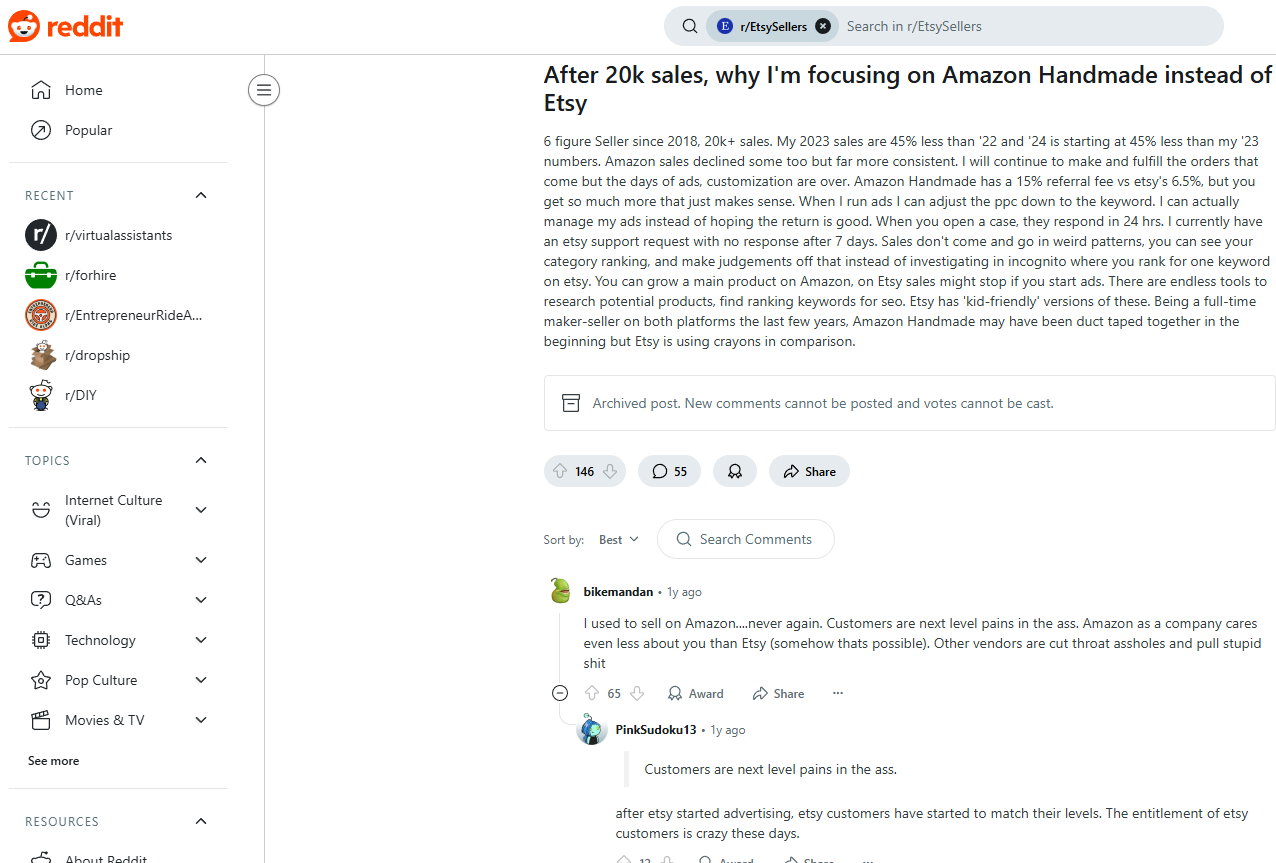
Despite Etsy’s lower 6.5% fee, they found Amazon’s 15% cut worthwhile because of its tools, analytics, and faster support. “Amazon may have started rough,” they wrote, “but Etsy still feels like it’s run with crayons.”
Others, however, highlight Amazon’s return culture as a real headache.
“Customers are next-level entitled,” one seller vented. Etsy’s customer base used to be more respectful, but now that Etsy is pushing ads, expectations are just as high—and often just as unreasonable.
One seller praised Etsy’s creative freedom and branding potential but admitted that Etsy “randomly pulls bestsellers from search” and doesn’t communicate changes well.
Others noted Etsy’s listing fees and lack of reliable traffic compared to Amazon’s massive reach and zero-listing-cost model.
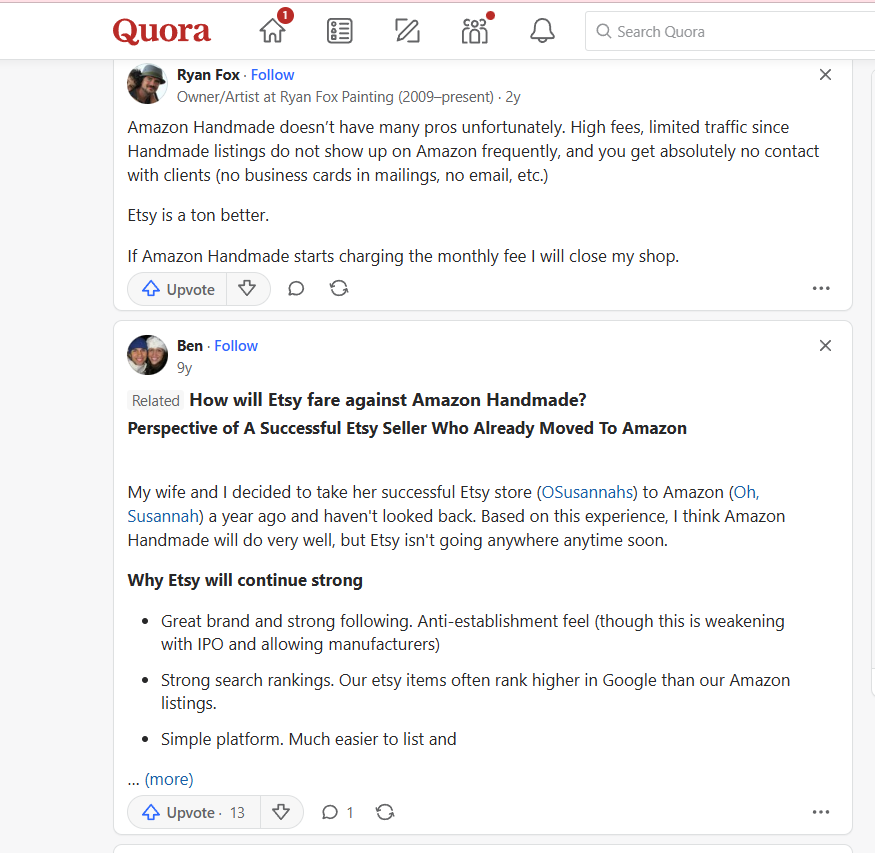
Still, there’s no perfect choice. Many experienced sellers now use both platforms to diversify, reduce stress, and stabilize income.
The consensus? Etsy is emotional, Amazon is practical. You’ll need to balance creativity with data—and expect some chaos either way.
FAQ: Amazon Handmade vs Etsy
1. Is it cheaper to sell on Amazon Handmade or Etsy?
Etsy charges $0.20 per listing and a 6.5% transaction fee, which works well for small or growing shops. Meanwhile, Amazon Handmade has no listing fees, but it takes 15% from each sale. It also requires a $39.99/month Professional Seller plan, but this is waived after approval for Handmade.
👉 If you sell fewer items, Etsy is cheaper. For high-ticket or high-volume sales, Amazon’s flat fee structure can work better.
2. What can you sell on Amazon Handmade vs Etsy?
3. Can you use dropshipping on Etsy or Amazon Handmade?
On Etsy, traditional dropshipping is not allowed, but print-on-demand (POD) is okay if it features your original design. You must disclose production partners and maintain creative control.
Amazon Handmade prohibits dropshipping. Products must be created by you or a team of under 20 people. You can use FBA for shipping, but outsourcing production is not allowed.
4. Which platform offers better branding and store customization?
You can customize store banners, logos, layout, featured listings, and link to socials. You get full control over your storefront.
Amazon Handmade provides a basic Maker Profile and limited visual branding unless you’re enrolled in Brand Registry (which requires a trademark).
5. How do the signup processes compare?
You can open a shop in just a few hours by adding your info, verifying your identity, and paying the $0.20 listing fee.
Amazon Handmade requires a Professional Seller account, then a Handmade application with detailed proof of how your products are made. Approval may take a few days to weeks and involves strict vetting.
6. Which platform has a better audience for handmade goods?
It has over 95 million buyers who actively look for unique, custom, or vintage goods. These customers value creativity and are willing to pay more.
Amazon Handmade taps into Amazon’s 300+ million global users, but most shoppers are browsing for convenience, not crafts.
7. Should I sell on both Amazon Handmade and Etsy?
Start on Etsy to build your brand, get feedback, and learn what sells. Once you gain traction, expand to Amazon Handmade to tap into a wider market and offer Prime shipping.
Many successful sellers use both platforms strategically, adapting listings and tone to each. Want to try both with niche products? Explore gaming gear or fitness dropshipping ideas too.
Final Thoughts
Both platforms have pros and cons and offer different functionalities to help you start your dropshipping business.
Etsy is ultimately cheaper, but Amazon Handmade offers a broader reach and can get you more clients with less work.
However, the people on Etsy have a bigger chance of buying your products since Etsy is a specialized business for handmade and vintage, thus targeting your niche better. Also, it gives you more freedom in storefront customization and branded packaging.
It’s also easier to set up an account on Etsy than on Amazon Handmade, but Amazon offers to ship and fulfill your orders.
To sum up, Etsy is better if you are just starting, and Amazon Handmade is better for reaching more customers.













![The Top 21 3PL Companies Compared [2025 List & Guide]](https://images.weserv.nl/?url=https://prod-dropshipping-s3.s3.fr-par.scw.cloud/2024/03/Frame-3922469.jpg&w=420&q=90&output=webp)